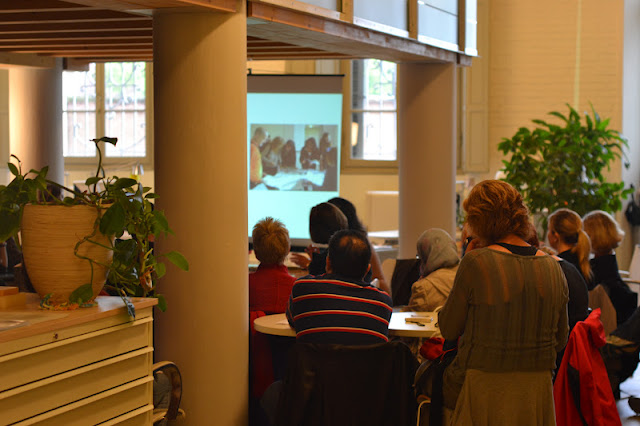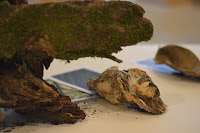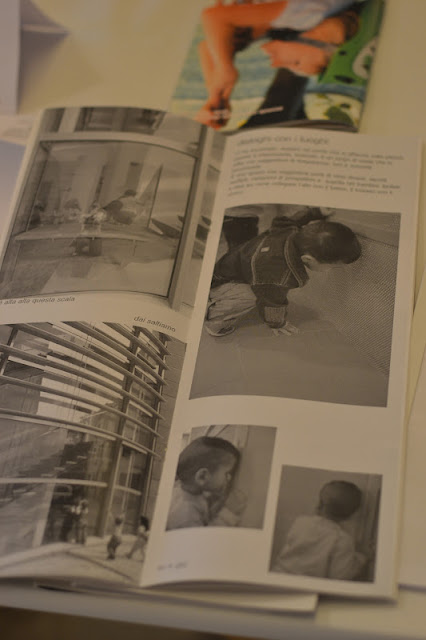Francesca, Myself, Nerida and Maddalena
Shelves full of various documentation in the Centre for Documentation and Educational Research
produced by the 64 schools of Reggio Emilia, Infant Toddler Centers and Preschool (and now State School)

Centre for Documentation and Educational Research adjacent to the exhibition center of Reggio Children, Marca Gerra
Discussions with teachers, pedagogists and atelieristas
Maddalena Talking about the International Primary State school
She is the pedagogist for the 3-6 yr
We have two years of time determine literacy and numeracy
Unfortunately teachers are using a textbook and these text books are then the deciders of how the teacher is going to teach that topic.
So it is publishing houses that are determining the curriculum in this case. The teacher supplies a simplified version of this textbook. We have abolished this textbook, we are building this educational approach it is it the most interesting and important job the teacher has.
What we are doing at the center is putting the teacher in the frame.
The approach is not yet based on research that is testing.
In the future, the school is still based on a discussion on reasoning, on assessment what we are trying to achieve, Our challenge is to construct a way of working where we see children as people, we will have a interdisciplinary approach where we have time to carry out investigations, as well as small and large groups, where we take the opportunity to work with many expressive language and the technological languages that children are aware of, a great variety of experiences and languages, learning experiences where we are not trying to pass down knowledge from high down, in January we are going to have an in depth look at our Primary school. February we look at the continuality of Primary, February 17th-23th, 2013, this is an important week as it is Loris Malaguzzi’s birthday in depth look and a publication will be produced looking at this review?? Not sure I heard correctly.
What do we mean the graphic language does not involve a unilateral interpretation? It is language closely connected to many other languages, it is a languages that learns about itself, a person can learn as they are learning about the subject they are drawing, light and form depth about the immaterial nature of things, and they can also just learn how drawing can make our learning visual. Drawing can also be theory it can be very close and exist along side other expressions such as writing. Just think about a music score how it is written and it’s played.
The graphic is constantly interacting with other languages. It is also has to do with representing movement how a body moves in space. Other materials also resemble drawing such has wire and the body as well. These materials kind of draw in space, like lines in a way.
How do we support children to see themselves as inquirers? I think that having curious adults that are capable of amazement it creates that invisible energy of learning. For children to be able to see that an adult is getting amazed and learning along with them is a strong impulse for their learning. There are two sides to that tho, it is important not to be too naive, not just ohh how amazing, not being superficial – don’t consider them cute or nice it is so superficial for an adult.
We should not accept that a child just makes a comment about a research or topic, lets say a group of children are discussing, don't list there series of opinions or ideas, there must interact have a dialogue. Our thoughts and ideas need to mix, if the teacher has this approach, they are trull listening. Are you sure? What I think of that is the teacher supports critical thinking, not just supporting political correct ideas.
These were the last words I heard from the Conference that really has left quite a deep impact on my teaching and learning. Our team, Amy, Amelia, Nerida and I, are still yet to dissect the the importance of this conference to our teaching at BEPS, but we are keen to impart our knowledge with our colleagues, and are preparing for a presentation to share our thoughts and learning next week. At which time we will be able to collectively update this blog and I hope share what changes this experience has brought to our students' teaching and learning.
These were the last words I heard from the Conference that really has left quite a deep impact on my teaching and learning. Our team, Amy, Amelia, Nerida and I, are still yet to dissect the the importance of this conference to our teaching at BEPS, but we are keen to impart our knowledge with our colleagues, and are preparing for a presentation to share our thoughts and learning next week. At which time we will be able to collectively update this blog and I hope share what changes this experience has brought to our students' teaching and learning.























































































